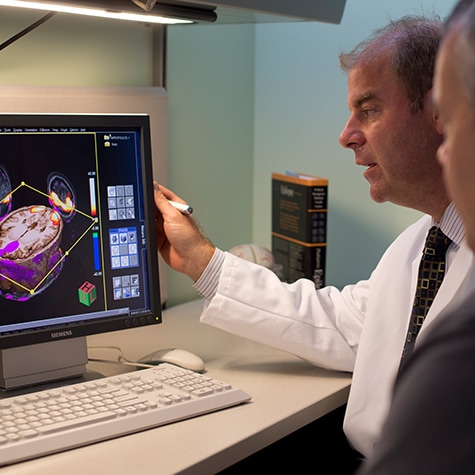An electroencephalogram (EEG) measures the electrical signals of your child’s brain through small button electrodes that are placed on your child’s scalp. Experts in neurology have studied EEGs for many years and determined that it is generally a safe procedure, with no significant risks.
There are three types of EEGs:
- Traditional EEG: Takes place in a clinic setting with about 25 electrodes.
- Dense Array EEG: Takes place in a clinic setting with about 250 electrodes.
- Ambulatory EEG: Takes place in a child’s normal daily setting. Electrodes are put on the scalp, and the patient is given a backpack that records the test results over several days.
Your child’s doctor will help decide which EEG is right for him. Learn more about each one:
It is important to follow these directions to get a good reading. If not, you might have to repeat or reschedule your child’s appointment.
Your child needs to be sleepy for the test.
- Keep your child up two to three hours later than usual the night before the test.
- Get him up two to three hours earlier than usual the morning of the test.
- Children over 3 years of age should not sleep more than five hours the night before the test.
- Do not let your child nap the day of the test.
Your child’s care team will give you instructions about when your child can eat before and after the procedure.
- Your child may eat or drink a regular diet before the test but may not have foods or drinks with caffeine (such as sodas, coffee or tea) or anything that is high in sugar. Natural sugars such as fruit are OK.
- If your baby still takes a bottle, bring full bottles with you.
- Wash and rinse your child’s hair the night before the test. Do not use any oil, gel or hairspray. If your child’s hair is long, do not braid it or put it up. Remove any hair extensions. Bring a comfort item, such as a pacifier or blanket, if needed. If your child is a baby or toddler, bring diapers with you.
Bring a list of all the medications your child takes (including dosage and schedule).
- If your child is taking medicine, give it at the regular time if this is at least two hours before the test time.
- If the medicine is due during the two hours before the test, check with your doctor to see if it should be given early or held until after the test.
Arrive at the hospital 30 minutes early to allow time to park and register.
- A traditional EEG can take as long as an hour and a half. If you are more than 15 minutes late, you may have to reschedule your child’s appointment.
- Bring payment for parking (Children’s Healthcare of Atlanta does not validate).
To get the maximum information from this test, your child’s physician will try to record the EEG during wakefulness and sleep.
- A trained, registered neurophysiology technologist will perform the test.
- Your child will be asked to lie down on a bed or stretcher. The technologist will explain the procedure to you and your child.
- The EEG technologist will prepare your child’s head for wires called electrodes (small, flat, round disks) that will be placed on your child’s scalp. The technologist will measure your child’s head and make small marks on the scalp with a washable marker or pen. Each marked area will be rubbed with a gritty lotion so the electrodes transmit well. Glue is put on the electrodes, which will be applied to each of the marked spots on the scalp. We may wrap your child’s head in gauze to hold the electrodes in place. The electrodes do not hurt or shock your child.
- The electrodes will then be connected to the EEG machine, and the test will begin. The machine records the electrical activity of the brain.
- After the technician checks all the sensors, the technician will take the first reading while your child is awake. Your child will breathe quickly for three minutes for the next part. We will turn out the lights, and your child will sleep for 10 to 15 minutes. When your child wakes up, the technician will use flashing lights to test his reaction. He can keep his eyes closed as long as he does not go back to sleep.
- The test can take as long as an hour and a half. If your child’s doctor asks for a video EEG to give more time to study the brain waves, the procedure may take longer. It may last six to eight hours.
- Your child may be videotaped during an EEG.
A dense array EEG is a crucial tool in the evaluation of epilepsy. Just as MRIs and CT scans allow a structural image of the brain, dense array EEG is a way to electrically image the brain. It is an important tool for finding abnormal electrical activity in children who are candidates for epilepsy surgery, such as seizures.
A dense array EEG measures and records the brain’s electrical activity by using up to 256 electrodes. By placing this many electrodes at key points on the patient’s head, doctors are able to get a good idea of where a child’s seizures start.
The seizures can be seen by the changes in the normal patterns of the brain’s electrical activity.
A dense array EEG has:
- More complete coverage of the head: The dense array EEG uses more electrodes and up to 256 channels, compared to the 19 to 21 channels used by traditional EEG systems. This provides better accuracy and localization at the source of the activity.
- Quick application time: Electrodes are arranged in a web-like structure, called the Geodesic Sensor Net. The electrodes can be applied in approximately 30 minutes.
- Increased patient comfort: The dense array EEG experience is virtually painless because there is no abrasion to the scalp.
It is important to follow the directions to get a good reading. If not, you might have to repeat or reschedule your child’s appointment.
- Wash and rinse your child’s hair the night before the appointment. Do not use any oil, gel or hairspray. If your child’s hair is long, do not braid it or put it up. Remove any hair extensions.
- Dress your child in a button-down shirt.
- Allow your child to eat and drink as usual.
- Give your child all his daily medicine unless otherwise instructed by your doctor. Bring a list of all the medications your child takes (including dosage and schedule).
- Arrive at the hospital 30 minutes early to allow time to park and register.
- Setting up the test takes about an hour. If you are more than 15 minutes late, you might need to reschedule your child’s appointment.
- Bring payment for parking (Children’s does not validate).
- A trained, registered neurophysiology technologist will apply the electrodes and set up the equipment.
- The EEG technologist will prepare your child’s head for wires called electrodes (small, flat, round disks) that will be placed on your child’s scalp. The technologist will measure your child’s head and make small marks on the scalp with a washable marker or pen. Each marked area will be rubbed with a gritty lotion so the electrodes transmit well. Glue is put on the electrodes, which will be applied to each of the marked spots on the scalp. We may wrap your child’s head in gauze to hold the electrodes in place. The electrodes do not hurt or shock your child.
- The electrodes will then be connected to the EEG machine, and the test will begin. The machine records the electrical activity of the brain. Your child will carry home this machine in a backpack to record his brain’s signals.
- You will need to help during the ambulatory EEG by keeping a record of your child’s episodes and by pressing the “event” button if your child shows any of the signs of his condition. This will help us notice important changes.
- Your child should not chew gum or suck on hard candy during the test.
After the one- to three-day test, your child will return to the hospital. The technologist will:
- Remove the electrodes and wires. The glue will be washed off with warm water and a washcloth. If the glue does not come all the way off, you may need to wash it out of your child’s hair at home.
- Give you any special instructions you may need and tell you when you may leave.
A neurologist will read the EEG and talk to your child’s doctor about the results.
An ambulatory EEG measures the electrical signals of your child’s brain while he is going about his everyday activities. These include playing with friends, watching TV and sleeping. Your child will carry home a special recorder in a backpack to record his brain’s signals.

During an EEG, special sensors are placed all over the head to measure the electrical signals the brain sends out. The test may take longer than an hour, but it should be painless.
Getting an EEG
watchHaving a child diagnosed with a neurological condition can be an emotional and overwhelming experience. At Children’s Healthcare of Atlanta, our No. 1 priority is to support you and your family. We make it our mission to provide the best care—and best experience—for every child we treat. As a parent, you play an important role in your child’s well-being. Not only are you a vital member of your child’s healthcare team, you are a source of security and comfort.

Our care extends beyond the hospital walls, with camps and other support services after your child goes home.
Contact Us 404-785-KIDS (5437)